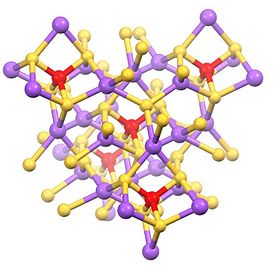Schlippe's Salt
 |
|
| Names | |
|---|---|
|
IUPAC name
Sodium tetrathioantimonate(V)
|
|
| Identifiers | |
| ECHA InfoCard | 100.208.207 |
| Properties | |
| Na3SbS4·9H2O | |
| Appearance | Yellow crystals |
| Density | 1.806 g/cm3, solid |
| Melting point | 87 °C (189 °F; 360 K) |
| Related compounds | |
|
Other cations
|
Potassium thioantimoniate |
|
Related compounds
|
Antimony(III) sulfide |
|
Except where otherwise noted, data are given for materials in their standard state (at 25 °C [77 °F], 100 kPa).
|
|
|
|
|
| Infobox references | |
Sodium thioantimoniate is an inorganic compound with the formula Na3SbS4. The nonahydrate of this material is known as Schlippe's salt, named after K. F. Schlippe (1799–1867), These compounds are examples of sulfosalts. They were once of interest as species generated in qualitative inorganic analysis.
This hydrated salt consists of the tetrahedral SbS43− anion (rSb-S = 2.33 Å) and sodium cations, which are hydrated. Related salts are known for different cations including ammonium and potassium.
The anhydrous salt is polymer with tetrahedral Na and Sb sites.
Sodium thioantimoniate is prepared by the reaction of antimony trisulfide, elemental sulfur, and aqueous sulfide source.
The sulfide can be generated indirectly by the thermal reaction of elemental sulfur with sodium hydroxide or even charcoal:
In the latter route, a mixture of sodium sulfate (16 parts) is reduced by fusion with charcoal (4-5 parts) in the presence of antimony sulfide (13 parts). The melt is extracted into water which is treated with sulfur (4 parts). Upon evaporation of the solution, the salt crystallizes as large tetrahedra, which are easily soluble in water. The anhydrous salt melts easily on heating, and in the hydrated condition, on exposure to moist air becomes coated with a red film.
The required antimony(III) sulfide is prepared in the usual way by treatment of virtually any Sb(III) compound with sulfide sources:
The hydrate dissolves in water to give the tetrahydral SbS43− ion. The salt gives "quinsulfide antimony," upon acidification:
...
Wikipedia
